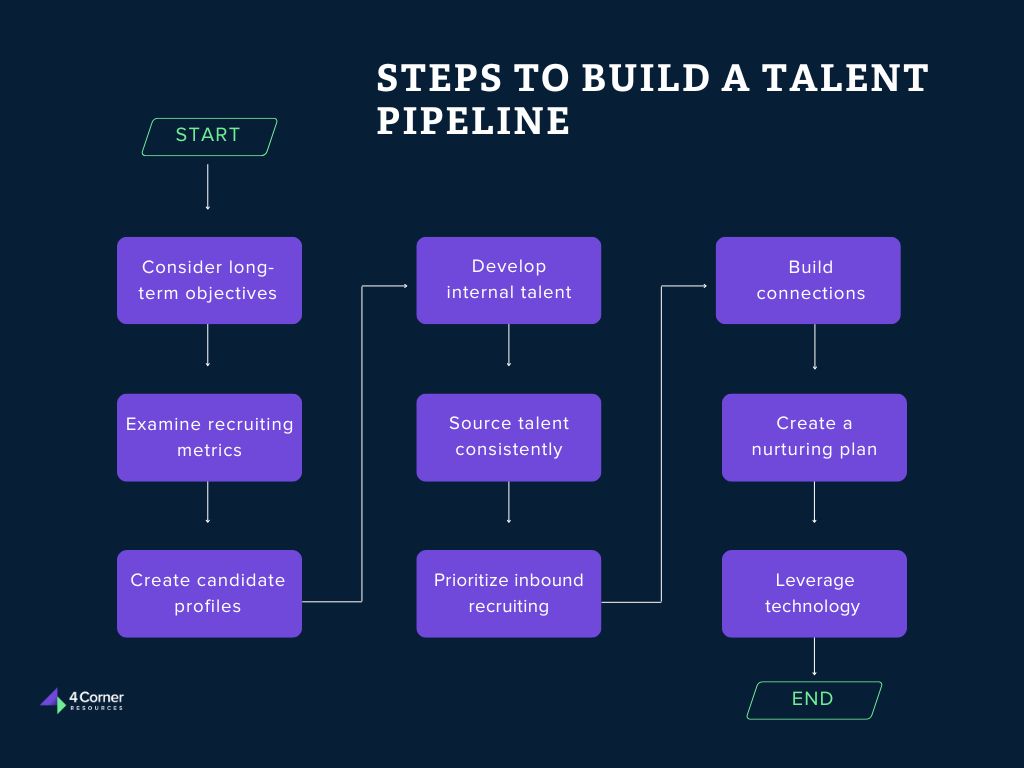
If you wait until you have an open position to start looking for candidates to interview, you’re already behind the eight-ball. In our experience, a reactive approach to hiring not only leads to positions staying vacant longer but also reduces productivity.
We’ve found that a more proactive strategy—building a talent pipeline—can make all the difference. By consistently engaging with qualified candidates, you can reduce the time it takes to fill key roles and ensure you have the right people ready when the need arises.
In this post, we’ll share insights on the benefits of a strong talent pipeline and offer practical steps to create one that aligns with your organization’s specific needs.
What Is a Talent Pipeline?
A ‘talent pipeline’ describes an approach to hiring that involves cultivating a pool of high-quality applicants the company may one day want to hire. These candidates may or may not be linked to a specific position.
For example, your talent pipeline might include an expert software engineer you met at a conference, a college student who interned with you and is about to graduate, or a visionary thinker who’d make a great C-suite executive should one of you decide to retire.
Building a talent pipeline is an active recruiting strategy rather than a passive one. This means you take steps to attract talent continuously, not just when you have positions you need to fill.
Any business or organization can use the talent pipeline strategy. However, it should be tailored to your specific needs and business goals, just as your marketing strategy is tied to your unique sales goals.
The Benefits of Creating a Talent Pipeline
Reduces time-to-hire
When you have a pool of top-tier candidates at the ready, you can hire faster and with less effort than when you have to go out and source a group of candidates from scratch. A faster hiring timeline also means lower hiring costs. For example, when we worked with a fast-growing tech company, they faced a sudden need to fill multiple software engineering roles. Thanks to the talent pipeline we had been cultivating, we were able to present them with a shortlist of highly qualified candidates within days. Instead of scrambling to source new candidates from scratch, they were able to fill the roles swiftly and reduce their overall hiring timeline by 40%.
Reduces resources
A talent pipeline requires ongoing effort to develop. However, it’s also very conducive to automation, so once the initial systems are in place, they can run with fewer resources, like staff members and labor hours.
Improves quality
When you hire reactively, you often scramble to find a qualified candidate, which can lead to hasty decisions and hiring mistakes. A talent pipeline facilitates a methodical structure, which allows time for more careful hiring decisions.
Ready to hire someone great?
Connect with our recruiting professionals today.
Nurtures candidates
Creating a talent pipeline requires strategic thinking about hiring. It’s a big-picture, long-game approach built of many smaller parts. Each of these parts contributes to the candidate experience, building a positive impression of your brand and nurturing potential future employees in a way that’s impossible when you’re merely cold-emailing candidates you found online.
Increases access to passive candidates
A talent pipeline is an ideal strategy for engaging with passive candidates–those people who are not actively looking for a job but who may be open to one if the right opportunity comes along. By nurturing relationships over time, you give passive candidates a chance to get to know your brand and decide you’d be a great company to work for. Then, when a position that suits their skills becomes available, they’re more likely to be interested.
Enhances employer branding
Building a talent pipeline gives you a prime opportunity to build and control your employer brand, which is the image you strive to create among potential job applicants. When candidates are consistently engaged with relevant communications in a talent pipeline, they gain a positive perception of your company and have a chance to internalize all of the recruitment messaging you’re distributing. A strong employer brand makes it easier to attract top talent in the future.
Minimizes business disruption
Sudden departures and unexpected vacancies can negatively impact operations and threaten relationships with clients, partners, and suppliers. Having a ready-to-go pipeline of qualified candidates allows you to fill openings quickly, minimizing disruption and ensuring business continuity.
For example, one of our clients, a healthcare provider, faced the unexpected resignation of a key operations manager, which could have caused serious interruptions in patient care and coordination with suppliers. Because we had already established a pool of qualified candidates for them, we were able to help them fill the position within a week, ensuring their operations continued smoothly. The rapid response prevented any gaps in service, preserving their relationships with both patients and suppliers.
Increases agility
The most resilient companies are those that can adapt to change quickly, be it the market, customer preferences, the economy, or any other factor that influences business. A talent pipeline allows organizations to hire quickly and effectively, which not only empowers them to respond to shifts but also enables them to secure talent before their competitors do.
Related: How to Hire Faster Through Candidate Nurturing
Steps to Build a Talent Pipeline

1. Consider long-term objectives
A talent pipeline should be built according to the company’s long-term objectives.
Consider the organization’s direction, business plans, and any strategic initiatives on the horizon. These could include mergers, acquisitions, going public, changing locations, restructuring, etc. How will these impact the key roles that need to be filled in the future?
For example, if your company plans to open a satellite location in the next 24 months, you need to start generating talent for that location now. It should be fairly straightforward to map out the staff the new location will require, enabling you to begin creating recruiting campaigns for talent with the necessary skills.
Also, routine talent needs should be considered no matter what happens in the business. Employees quit, retire, move, and do all sorts of other things that cause positions to become available. Your ongoing strategy should also address these needs.
2. Examine recruiting metrics
Your recruiting metrics are an invaluable source of intel about where to focus your efforts. Some of the top metrics to look at include source of hire, which can tell you which channels bring you the most and least recruiting success, and turnover rates by department, which can indicate the types of roles that are most important to prioritize.
Related: How to Leverage Data to Improve Your Recruitment Process
3. Create candidate profiles
Candidate profiles, also called candidate personas, help you gain clarity on the types of people you’re looking for to fill open roles in the future. These profiles outline technical skills, soft skills, qualifications, experience, personality traits, culture fit, and other important characteristics of your organization. These profiles give you a concrete audience for which to develop content, helping you decide what information is most relevant and useful to include in your nurturing campaigns.
4. Develop internal talent
Your existing employees are the easiest well to tap when filling your talent pool.
Examine your department’s staffing chart on an annual or quarterly basis. Assess which employees demonstrate leadership potential or an aptitude for upskilling. Feed your talent pipeline by supporting their development in a way that also meets your hiring needs.
Related: How to Conduct an Internal Interview
5. Source talent consistently
Taking a talent pipeline approach means you’re always building your talent pool, even when you don’t need a certain candidate’s skills or have a place for them on your team right now. The core concept is to develop them as candidates so that they’re there when you need those skills.
Here are just a few of the channels to tap into to source talent:
- Networking events
- Industry conferences
- College hiring fairs
- Professional organizations
- Recruitment marketing campaigns
- Social media
- Employee referrals
Map out initiatives that will cultivate talent on these channels on an ongoing basis. Again, your recruitment metrics can help you determine where to direct your efforts.
6. Prioritize inbound recruiting
In addition to actively sourcing talent, build your talent pipeline by drawing candidates into it. This is known as inbound recruiting, the process of creating campaigns that get candidates to come to you rather than you seeking them out.
Inbound recruiting might include:
- Creating content that showcases what it’s like to work for your company
- Making strategic posts on social media
- Using gamification on candidate-facing website pages
- Installing chatbots to engage website visitors
- Using SEO to attract searchers who display an interest in your industry
Be sure to provide a call to action, like a form or text message opt-in, to help interested candidates connect with you.
7. Build connections
Now it’s time to reach out to the candidates you’ve zeroed in on for your talent pipeline. But rather than prompting them to apply for a specific position, your approach should focus on learning more about them: their skills, career objectives, and what they’re looking for in their ideal employer. How can you become the employer of choice for their next career move?
Use a tool like an applicant tracking system to record what you learn and build increasingly insightful profiles on each candidate in your pipeline.
For instance, when we were working with a leading marketing agency, we engaged with several high-potential digital marketing professionals early on—not with a job offer, but with conversations focused on understanding their skills, career goals, and what they were looking for in an ideal employer. By consistently checking in and learning more about them over time, we were able to develop detailed profiles using our applicant tracking system. This approach paid off when the agency needed to fill a director-level role, and we already had a strong relationship with the ideal candidate, making the hiring process smooth and fast.
8. Create a nurturing plan
As we said above, building a talent pipeline is a long game. Strategize how you’ll nurture your relationships with candidates over time by providing relevant, engaging content on platforms that make sense for the candidate.
Here are some ideas:
- Sending company news via email
- Sending job alerts via text message
- Inviting candidates to webinars, meetups, and other events you’re hosting or participating in
- Sharing industry insights and career development resources on social media
- Creating videos to spotlight employee achievements and your value proposition for new hires
A well-developed nurturing plan contributes to building your employer brand so that when you have an opening that’s a perfect match for a candidate, choosing to work for you is a no-brainer.
9. Leverage technology
Technology can be a powerful ally in ensuring that the engaging materials you’ve crafted reach the right candidates with minimal effort. An applicant tracking system allows you to monitor candidate statuses and update profiles as needed easily. AI-powered sourcing tools help identify potential candidates and match them with suitable roles, streamlining the selection process. Additionally, automation tools enable you to segment your audience and schedule emails or other communications to be sent at optimal times, ensuring your outreach is both targeted and timely.
Creating a talent pipeline takes work, but when done successfully, it can speed up your time to hire, improve the quality of your candidates, and ultimately help you build a stronger workforce.
Tips for Managing Your Talent Pipeline
Update candidate information regularly
Keep your database updated by regularly updating candidate profiles when they gain new skills, change jobs, or move locations. You can do this manually at regular intervals (e.g., every three or six months) or use automated tools to monitor platforms like LinkedIn and gather the most current candidate information.
Segment your talent pool
Not all candidates in your pipeline are at the same stage of their career or are interested in the same types of roles. Use segmenting to divide talent into smaller pools based on their skills, interests, experience level, and other criteria. Maximize engagement by creating and sending content tailored to those segments.
Engage contacts consistently
Talent pipelines are about building ongoing communication even when there isn’t a job opening–or, more appropriately, ESPECIALLY when there isn’t a job opening. Candidates should feel like a valued part of your circle and not just an asset you’re looking to capitalize on. Regularly scheduled, consistent engagement is key to maintaining interest and reducing drop-offs.
Prioritize personalization
Even when you’re working with a large pool of candidates, personalization is essential for nurturing meaningful relationships. Use candidates’ names in your communications and leverage tagging to reference their specific skills or relevant job titles. Incorporate dynamic content that changes based on a candidate’s actions. For example, if a candidate clicks link A, they might receive an email with a video, but if they click link B, they might be invited to a webinar.
Monitor pipeline health regularly
Though a talent pipeline is a long-term strategy, candidates shouldn’t stay in your pipeline indefinitely. Regularly review your contacts and clean those that are outdated or inactive. Use a re-engagement campaign to try to recapture those who haven’t interacted with your content in a while. Monitoring your pipeline health helps keep your talent pool manageable and keeps you from getting into trouble with spam filtering tools.
Partner with a reputable staffing agency
If all of the above sounds outside the bounds of your available resources or current capabilities, an experienced staffing agency can lighten the load. A reputable firm like 4 Corner Resources can help you develop a highly targeted, skilled pipeline of talent to hire faster and with greater accuracy. Ready to start building your pipeline? Get in touch with us today.


